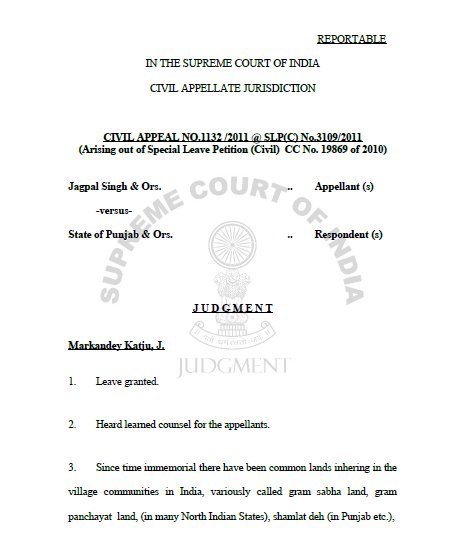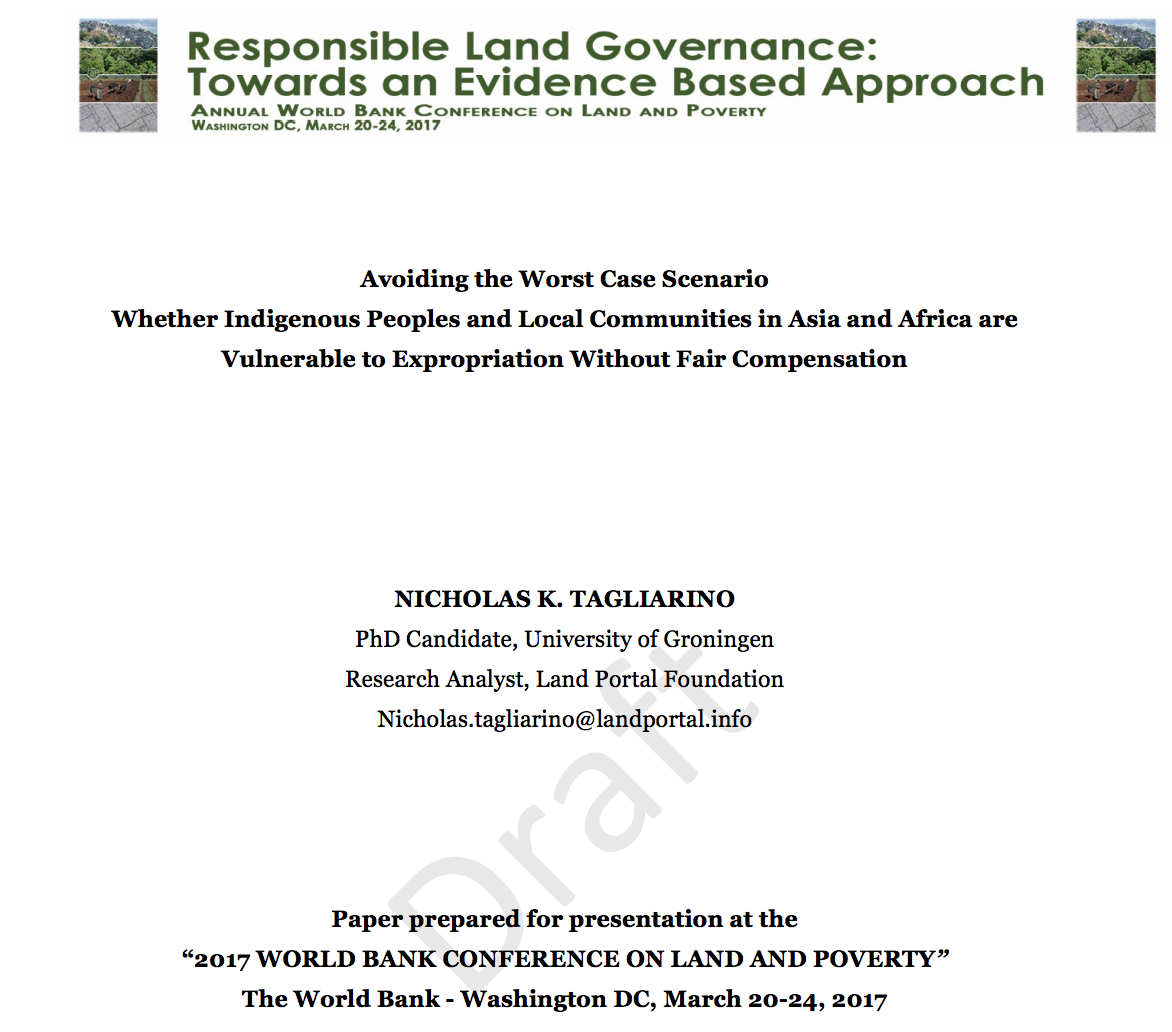commons
AGROVOC URI: http://aims.fao.org/aos/agrovoc/c_778a14cf
Subdividing the Commons: The Politics of Property Rights Transformation in Kenya’s Maasailand
This paper discusses the internal processes and decisions that characterized thetransition from collectively held group ranches to individualized property systems amongthe Maasai pastoralists of Kajiado district in Kenya. It addresses the question of whygroup ranch members would demand individualized property systems, but then turnagainst the outcome. In addressing this puzzle the paper discusses the process of landallocation and distribution during group ranch subdivision.
Supreme Court of India Judgment on Village Common Land in Case of Jagpal Singh & Ors vrs. State of Punjab & Ors. (Civil Appeal No.1132 /2011 @ SLP(C) No.3109/ 2011
This is a judgment of Supreme Court of India to check grabbing of village common land including ponds and water bodies (called in different names) by unscrupulous persons, political clout, powerful vested interests, corrupt state authorities, etc by fraudulent practices and ensure their protection and safeguard.
Avoiding the Worst Case Scenario:
This paper examines whether national expropriation and land laws in 30 countries across Asia and Africa put Indigenous Peoples and local communities at risk of expropriation without compensation. In particular, this paper examines whether national laws ensure that communities are eligible for compensation and whether eligibility requirements effectively close the door on communities seeking compensation.
The tragedy of public lands: The fate of the commons under global commercial pressure
Includes understanding the commons, getting to the sources of vulnerability, recommendations – making the playing field more equal for the poor.
Whose Land is it? Commons and Conflict States. Why the Ownership of the Commons Matters in Making and Keeping Peace
Addresses the tenure fate of three commons: the 30 million hectares of pasture lands of Afghanistan which represent 45 percent of the total land area and are key to livelihood and water catchment in that exceedingly dry country; the 5.7 million hectares of timber-rich tropical forests in Liberia, 59 percent of the total land area; and the 125 million hectares of savannah in Sudan, half the area of that largest state of Africa. All three resources have a long history as customary properties of local communities and also share a 20th century history as the property of the state.
Land Rights Reform and Governance in Africa. How to make it work in the 21st Century?
Divided into 7 sections: introduction – tenure insecurity, poverty and power relations; the subordination of customary land rights; attempts to make amends; an end of century turn-around – towards the liberation of customary land rights; launching reform through new policy and law; the need to assure success; how to make land reform work? Argues that dramatic improvement in the legal status of customary land interests is globally on the horizon.
La tierra como acervo de bienes comunes. Los conflictos sociales sobre bienes comunes ligados a la extranjerización de la tierra en la Argentina reciente
El tema del acaparamiento de tierras por parte de extranjeros ha sido ampliamente estudiado en distintas regiones del mundo, analizando las características de los inversores, las consecuencias sobre los campesinos que deben ser desplazados de sus tierras o los mecanismos por medio de los cuales los capitales extranjeros ocupan los territorios de la mano de los Estados locales. En este trabajo, queremos proponer un enfoque diferente: los efectos sobre los bienes comunes derivados de la extranjerización de la tierra, para el caso de Argentina.
Estrategias de organización social para la administración del bosque de San Juan Evangelista Analco, Oaxaca
La presente investigación tuvo por objeto analizar la organización social que existe en San Juan Evangelista Analco, Oaxaca para el manejo forestal comunitario. La compilación de datos se hizo mediante el uso de la “técnica etnográfica”, lo que hizo necesario aplicar técnicas de investigación de campo de tipo cualitativo, como la de “observación participante”, “genealogías” y “entrevistas”. Los resultados reflejaron que en la comunidad existe una organización comunitaria para la administración de los bosques basada en el capital social, que recae en el Comisariado de Bienes Comunales.
The deforestation and the tragedy of the commons between VRAE coca farmers: 2001 – 2004
Forests at the tropical Valley of the Apurimac and Ene rivers (VRAE), the second coca-growing region of Peru, are public common resources and nevertheless privately managed mainly by coca farmers, without effective State control of such use. The need for survival of the coca farmers, their chrematistic perception of the forest, the cultivation of cocoa (theobroma cacao) and land availability are crucial factors influencing the rates of deforestation of primary and secondary forest. Variables such as the legality of land tenure seem to have no influence.
Impact of climate and land use changes on water and food security in Jordan: implications for transcending 'the tragedy of the commons'
Jordan is dominated by arid climate with limited arable land and water resources. This study focuses on crop production and water resources under trends of anticipated climate change and population growth to analyse how these affect water and food security in the country. It finds that recession of irrigated areas led to lesser food production and food security. Results indicate that climate change and population growth increase and intensify problems of water scarcity and food insecurity.
Winners and losers: privatising the commons in Botswana
This paper explores key issues relating to the privatisation of livestock production in Botswana, with particular relevance to pastoral livelihoods.The paper reviews the history of land policy; summarises developments in recent years of rangeland policies; and analyses the economic, social and environmental impact of the process of privatising the commons in Botswana.Main conclusions include:the benefits of the privatisation of the commons have mainly been concentrated in the hands of a small number of wealthy cattle owners, an elite consisting largely of members or supporters of the ruling






